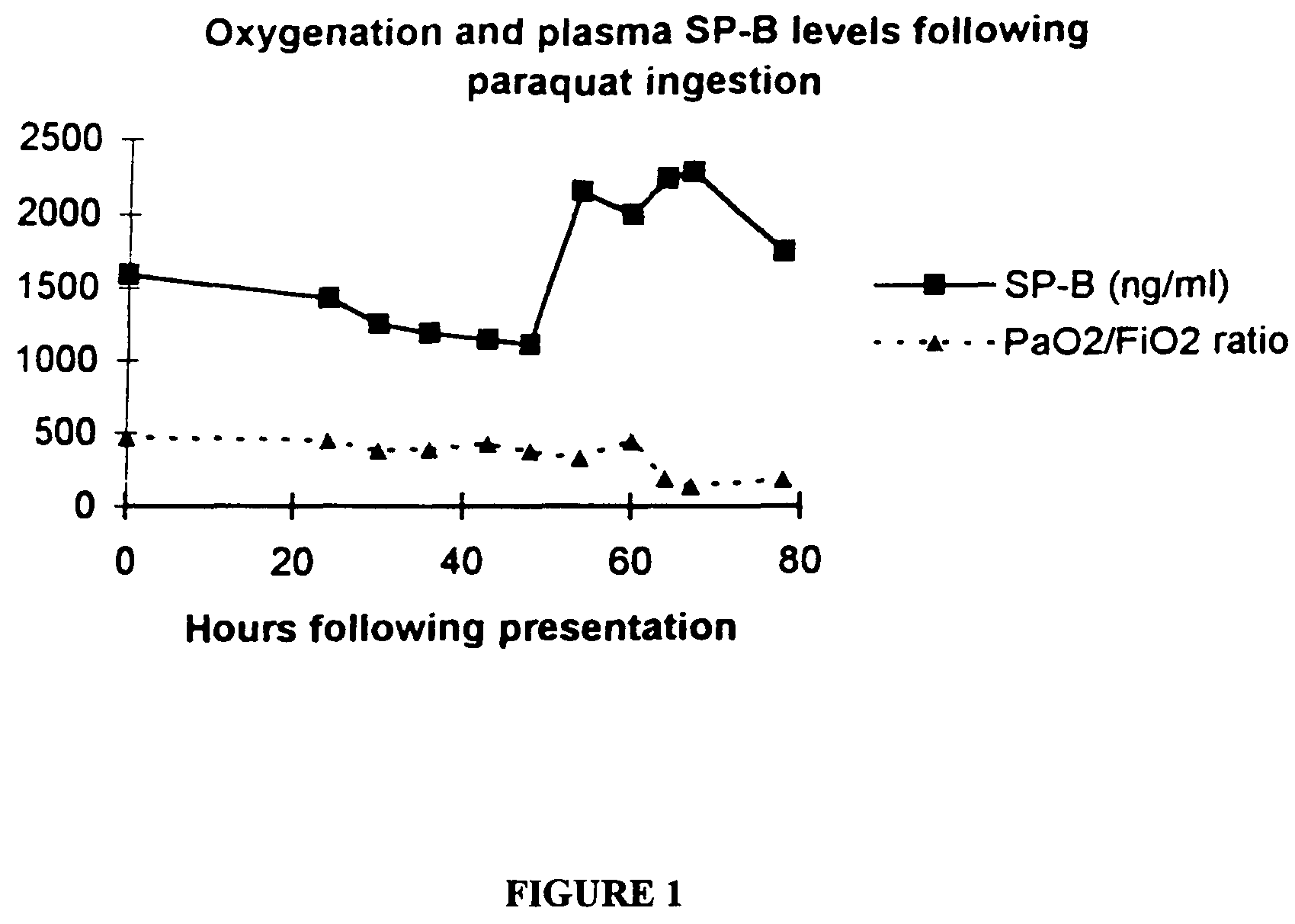Method of diagnosis
a technology of alveolar edema and diagnostic method, which is applied in the direction of biological material analysis, instruments, measurement devices, etc., can solve the problems of lung damage, alveolar edema, and impair the function of pulmonary surfactant, and achieve the effect of facilitating detection
- Summary
- Abstract
- Description
- Claims
- Application Information
AI Technical Summary
Benefits of technology
Problems solved by technology
Method used
Image
Examples
example 1
Sample Preparation and Storage
[0090]Blood, was immediately centrifuged in tubes (Disposable Products, Sydney, Australia) containing lithium heparin (plasma) or clot retraction accelerator (serum) at 5,000 rpm for min at room temperature (Megafuge; Heraeus-Christ, Osterode, Germany). Samples stored at −20° C. for batch analysis.
example 2
Primary Antibody Preparation
[0091]SP-A and SP-B were purified from the lavage fluid of patients with alveolar proteinosis. Each protein was emulsified with Freund's complete adjuvant (Difco Laboratories, Detroit, Mich.) and injected subcutaneously into 3 New Zealand white rabbits. The immunizations were boosted with SP-A or SP-B emulsified in Freund's incomplete adjuvant (Difco Laboratories). The rabbits were exsanguinated and IgG precipitated from the serum using 50% (vol / vol) saturated ammonium sulfate. The IgG was reconstituted to the original serum volume in 136.8 mM sodium chloride, 8.1 mM disodium hydrogen phosphate, 2.6 mM potassium chloride, 0.7 mM potassium dihydrogen phosphate containing 0.02% sodium azide and 0.05% (vol / vol) Tween 20 (PBST) and immunoadsorbed overnight at 4° C. against 200 ml of cross-linked, normal human serum. In order to remove any specificialities against soluble blood group A antigenic determinants, the cross-linked serum was prepared from pooled blo...
example 3
ELISA
[0093]SP-A and -B were determined by ELISA inhibition assays using SP-A and SP-B purified from alveolar proteinosis lavage fluid as standard.
[0094]Samples were assayed in a blind randomized manner. In order to free the SP-A and -B from any associated plasma or surfactant components, all samples were treated in the following manner. 125 μl aliquots were diluted in 500 μl of 10 mM Tris, 1 mM EDTA containing 0.25% BSA (pH 7.4). After vortexing at room temperature for 10 min, 125 μl of solution containing 3% SDS and 12% Triton X-100 (v / v) was added to each sample. The samples were again vortexed for 10 min and surfactant protein concentration determined using an ELISA inhibition assay.
[0095]The SP-A and SP-B assays were performed in 2 parts. Costar ELISA plates (Costar, Cambridge, Mass.; #2595) were coated overnight at 4° C. with purified SP-A or -B (1 μg / ml) in a solution containing 15 mM sodium carbonate, 35 mM sodium bicarbonate and 0.02% sodium azide (pH 9.6). The coated plates...
PUM
| Property | Measurement | Unit |
|---|---|---|
| molecular weight | aaaaa | aaaaa |
| pH | aaaaa | aaaaa |
| pH | aaaaa | aaaaa |
Abstract
Description
Claims
Application Information
 Login to View More
Login to View More - R&D
- Intellectual Property
- Life Sciences
- Materials
- Tech Scout
- Unparalleled Data Quality
- Higher Quality Content
- 60% Fewer Hallucinations
Browse by: Latest US Patents, China's latest patents, Technical Efficacy Thesaurus, Application Domain, Technology Topic, Popular Technical Reports.
© 2025 PatSnap. All rights reserved.Legal|Privacy policy|Modern Slavery Act Transparency Statement|Sitemap|About US| Contact US: help@patsnap.com

